Coxeter notation
C1v | C2v | C3v | C4v | C5v | C6v |
|---|---|---|---|---|---|
 Order 2 |  Order 4 |  Order 6 |  Order 8 |  Order 10 |  Order 12 |
[2] = [2,1] D1h | [2,2] D2h | [2,3] D3h | [2,4] D4h | [2,5] D5h | [2,6] D6h |
 Order 4 |  Order 8 |  Order 12 |  Order 16 |  Order 20 |  Order 24 |
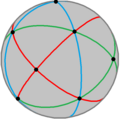 Order 24 | 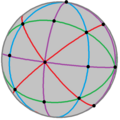 Order 48 |  Order 120 | |||
| Coxeter notation expresses Coxeter groups as a list of branch orders of a Coxeter diagram, like the polyhedral groups, | |||||
In geometry, Coxeter notation (also Coxeter symbol) is a system of classifying symmetry groups, describing the angles between fundamental reflections of a Coxeter group in a bracketed notation expressing the structure of a Coxeter-Dynkin diagram, with modifiers to indicate certain subgroups. The notation is named after H. S. M. Coxeter, and has been more comprehensively defined by Norman Johnson.
Reflectional groups[edit]
For Coxeter groups, defined by pure reflections, there is a direct correspondence between the bracket notation and Coxeter-Dynkin diagram. The numbers in the bracket notation represent the mirror reflection orders in the branches of the Coxeter diagram. It uses the same simplification, suppressing 2s between orthogonal mirrors.
The Coxeter notation is simplified with exponents to represent the number of branches in a row for linear diagram. So the An group is represented by [3n−1], to imply n nodes connected by n−1 order-3 branches. Example A2 = [3,3] = [32] or [31,1] represents diagrams ![]()
![]()
![]()
![]()
![]() or
or ![]()
![]()
![]() .
.
Coxeter initially represented bifurcating diagrams with vertical positioning of numbers, but later abbreviated with an exponent notation, like [...,3p,q] or [3p,q,r], starting with [31,1,1] or [3,31,1] = ![]()
![]()
![]()
![]() or
or ![]()
![]()
![]()
![]()
![]() as D4. Coxeter allowed for zeros as special cases to fit the An family, like A3 = [3,3,3,3] = [34,0,0] = [34,0] = [33,1] = [32,2], like
as D4. Coxeter allowed for zeros as special cases to fit the An family, like A3 = [3,3,3,3] = [34,0,0] = [34,0] = [33,1] = [32,2], like ![]()
![]()
![]()
![]()
![]()
![]()
![]()
![]()
![]() =
= ![]()
![]()
![]()
![]()
![]()
![]()
![]() =
= ![]()
![]()
![]()
![]()
![]() .
.
Coxeter groups formed by cyclic diagrams are represented by parentheseses inside of brackets, like [(p,q,r)] = ![]() for the triangle group (p q r). If the branch orders are equal, they can be grouped as an exponent as the length the cycle in brackets, like [(3,3,3,3)] = [3[4]], representing Coxeter diagram
for the triangle group (p q r). If the branch orders are equal, they can be grouped as an exponent as the length the cycle in brackets, like [(3,3,3,3)] = [3[4]], representing Coxeter diagram ![]()
![]()
![]()
![]()
![]() or
or ![]()
![]()
![]() .
. ![]()
![]()
![]()
![]()
![]() can be represented as [3,(3,3,3)] or [3,3[3]].
can be represented as [3,(3,3,3)] or [3,3[3]].
More complicated looping diagrams can also be expressed with care. The paracompact Coxeter group ![]()
![]()
![]()
![]()
![]() can be represented by Coxeter notation [(3,3,(3),3,3)], with nested/overlapping parentheses showing two adjacent [(3,3,3)] loops, and is also represented more compactly as [3[ ]×[ ]], representing the rhombic symmetry of the Coxeter diagram. The paracompact complete graph diagram
can be represented by Coxeter notation [(3,3,(3),3,3)], with nested/overlapping parentheses showing two adjacent [(3,3,3)] loops, and is also represented more compactly as [3[ ]×[ ]], representing the rhombic symmetry of the Coxeter diagram. The paracompact complete graph diagram ![]() or
or ![]()
![]()
![]() , is represented as [3[3,3]] with the superscript [3,3] as the symmetry of its regular tetrahedron coxeter diagram.
, is represented as [3[3,3]] with the superscript [3,3] as the symmetry of its regular tetrahedron coxeter diagram.
|
|
|
For the affine and hyperbolic groups, the subscript is one less than the number of nodes in each case, since each of these groups was obtained by adding a node to a finite group's diagram.
Unconnected groups[edit]
The Coxeter diagram usually leaves order-2 branches undrawn, but the bracket notation includes an explicit 2 to connect the subgraphs. So the Coxeter diagram ![]()
![]()
![]()
![]()
![]()
![]()
![]() = A2×A2 = 2A2 can be represented by [3]×[3] = [3]2 = [3,2,3]. Sometimes explicit 2-branches may be included either with a 2 label, or with a line with a gap:
= A2×A2 = 2A2 can be represented by [3]×[3] = [3]2 = [3,2,3]. Sometimes explicit 2-branches may be included either with a 2 label, or with a line with a gap: ![]()
![]()
![]()
![]()
![]()
![]()
![]() or
or ![]()
![]()
![]()
![]()
![]()
![]()
![]()
![]()
![]() , as an identical presentation as [3,2,3].
, as an identical presentation as [3,2,3].
Rank and dimension[edit]
Coxeter point group rank is equal to the number of nodes which is also equal to the dimension. A single mirror exists in 1-dimension, [ ], ![]() , while in 2-dimensions [1],
, while in 2-dimensions [1], ![]()
![]()
![]() or [ ]×[ ]+. The 1 is a place-holder, not an actual branch order, but a marker for an orthogonal inactive mirror. The notation [n,1], represents a rank 3 group, as [n]×[ ]+ or
or [ ]×[ ]+. The 1 is a place-holder, not an actual branch order, but a marker for an orthogonal inactive mirror. The notation [n,1], represents a rank 3 group, as [n]×[ ]+ or ![]()
![]()
![]()
![]()
![]() . Similarly, [1,1] as [ ]×[ ]+×[ ]+ or
. Similarly, [1,1] as [ ]×[ ]+×[ ]+ or ![]()
![]()
![]()
![]()
![]() order 2 and [1,1]+ as [ ]+×[ ]+×[ ]+ or
order 2 and [1,1]+ as [ ]+×[ ]+×[ ]+ or ![]()
![]()
![]()
![]()
![]() , order 1!
, order 1!
Subgroups[edit]
Coxeter's notation represents rotational/translational symmetry by adding a + superscript operator outside the brackets, [X]+ which cuts the order of the group [X] in half, thus an index 2 subgroup. This operator implies an even number of operators must be applied, replacing reflections with rotations (or translations). When applied to a Coxeter group, this is called a direct subgroup because what remains are only direct isometries without reflective symmetry.
The + operators can also be applied inside of the brackets, like [X,Y+] or [X,(Y,Z)+], and creates "semidirect" subgroups that may include both reflective and nonreflective generators. Semidirect subgroups can only apply to Coxeter group subgroups that have even order branches adjacent to it. Elements by parentheses inside of a Coxeter group can be give a + superscript operator, having the effect of dividing adjacent ordered branches into half order, thus is usually only applied with even numbers. For example, [4,3+] and [4,(3,3)+] (![]()
![]()
![]()
![]()
![]()
![]()
![]() ).
).
If applied with adjacent odd branch, it doesn't create a subgroup of index 2, but instead creates overlapping fundamental domains, like [5,1+] = [5/2], which can define doubly wrapped polygons like a pentagram, {5/2}, and [5,3+] relates to Schwarz triangle [5/2,3], density 2.
| Group | Order | Generators | Subgroup | Order | Generators | Notes | ||
|---|---|---|---|---|---|---|---|---|
| [p] | 2p | {0,1} | [p]+ | p | {01} | Direct subgroup | ||
| [2p+] = [2p]+ | 2p | {01} | [2p+]+ = [2p]+2 = [p]+ | p | {0101} | |||
| [2p] | 4p | {0,1} | [1+,2p] = [p] | 2p | {101,1} | Half subgroups | ||
| [2p,1+] = [p] | {0,010} | |||||||
| [1+,2p,1+] = [2p]+2 = [p]+ | p | {0101} | Quarter group | |||||
Groups without neighboring + elements can be seen in ringed nodes Coxeter-Dynkin diagram for uniform polytopes and honeycomb are related to hole nodes around the + elements, empty circles with the alternated nodes removed. So the snub cube, ![]()
![]()
![]()
![]()
![]() has symmetry [4,3]+ (
has symmetry [4,3]+ (![]()
![]()
![]()
![]()
![]() ), and the snub tetrahedron,
), and the snub tetrahedron, ![]()
![]()
![]()
![]()
![]() has symmetry [4,3+] (
has symmetry [4,3+] (![]()
![]()
![]()
![]()
![]() ), and a demicube, h{4,3} = {3,3} (
), and a demicube, h{4,3} = {3,3} (![]()
![]()
![]()
![]()
![]() or
or ![]()
![]()
![]() =
= ![]()
![]()
![]()
![]()
![]() ) has symmetry [1+,4,3] = [3,3] (
) has symmetry [1+,4,3] = [3,3] (![]()
![]()
![]()
![]()
![]() or
or ![]()
![]()
![]()
![]()
![]() =
= ![]()
![]()
![]() =
= ![]()
![]()
![]()
![]()
![]() ).
).
Note: Pyritohedral symmetry ![]()
![]()
![]()
![]()
![]() can be written as
can be written as ![]()
![]()
![]()
![]()
![]()
![]() , separating the graph with gaps for clarity, with the generators {0,1,2} from the Coxeter group
, separating the graph with gaps for clarity, with the generators {0,1,2} from the Coxeter group ![]()
![]()
![]()
![]()
![]() , producing pyritohedral generators {0,12}, a reflection and 3-fold rotation. And chiral tetrahedral symmetry can be written as
, producing pyritohedral generators {0,12}, a reflection and 3-fold rotation. And chiral tetrahedral symmetry can be written as ![]()
![]()
![]()
![]()
![]() or
or ![]()
![]()
![]()
![]()
![]()
![]() , [1+,4,3+] = [3,3]+, with generators {12,0120}.
, [1+,4,3+] = [3,3]+, with generators {12,0120}.
Halving subgroups and extended groups[edit]
 |  | |
[1,4,1] = [4] | [1+,4,1]=[2]=[ ]×[ ] | |
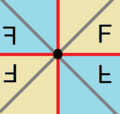 | 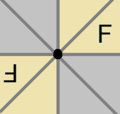 | |
[1,4,1+]=[2]=[ ]×[ ] | [1+,4,1+] = [2]+ | |
Johnson extends the + operator to work with a placeholder 1+ nodes, which removes mirrors, doubling the size of the fundamental domain and cuts the group order in half.[1] In general this operation only applies to individual mirrors bounded by even-order branches. The 1 represents a mirror so [2p] can be seen as [2p,1], [1,2p], or [1,2p,1], like diagram ![]()
![]()
![]()
![]() or
or ![]()
![]()
![]()
![]() , with 2 mirrors related by an order-2p dihedral angle. The effect of a mirror removal is to duplicate connecting nodes, which can be seen in the Coxeter diagrams:
, with 2 mirrors related by an order-2p dihedral angle. The effect of a mirror removal is to duplicate connecting nodes, which can be seen in the Coxeter diagrams: ![]()
![]()
![]()
![]() =
= ![]()
![]() , or in bracket notation:[1+,2p, 1] = [1,p,1] = [p].
, or in bracket notation:[1+,2p, 1] = [1,p,1] = [p].
Each of these mirrors can be removed so h[2p] = [1+,2p,1] = [1,2p,1+] = [p], a reflective subgroup index 2. This can be shown in a Coxeter diagram by adding a + symbol above the node: ![]()
![]()
![]()
![]() =
= ![]()
![]()
![]()
![]() =
= ![]()
![]() .
.
If both mirrors are removed, a quarter subgroup is generated, with the branch order becoming a gyration point of half the order:
- q[2p] = [1+,2p,1+] = [p]+, a rotational subgroup of index 4.





 =
= 


 =
= 


 =
= 


 =
= 
 .
.
For example, (with p=2): [4,1+] = [1+,4] = [2] = [ ]×[ ], order 4. [1+,4,1+] = [2]+, order 2.
The opposite to halving is doubling[2] which adds a mirror, bisecting a fundamental domain, and doubling the group order.
- [[p]] = [2p]
Halving operations apply for higher rank groups, like tetrahedral symmetry is a half group of octahedral group: h[4,3] = [1+,4,3] = [3,3], removing half the mirrors at the 4-branch. The effect of a mirror removal is to duplicate all connecting nodes, which can be seen in the Coxeter diagrams: ![]()
![]()
![]()
![]()
![]()
![]() =
= ![]()
![]()
![]()
![]() , h[2p,3] = [1+,2p,3] = [(p,3,3)].
, h[2p,3] = [1+,2p,3] = [(p,3,3)].
If nodes are indexed, half subgroups can be labeled with new mirrors as composites. Like ![]()
![]()
![]()
![]() , generators {0,1} has subgroup
, generators {0,1} has subgroup ![]()
![]()
![]()
![]() =
= ![]()
![]()
![]()
![]()
![]() , generators {1,010}, where mirror 0 is removed, and replaced by a copy of mirror 1 reflected across mirror 0. Also given
, generators {1,010}, where mirror 0 is removed, and replaced by a copy of mirror 1 reflected across mirror 0. Also given ![]()
![]()
![]()
![]()
![]() , generators {0,1,2}, it has half group
, generators {0,1,2}, it has half group ![]()
![]()
![]()
![]()
![]() =
= ![]()
![]()
![]()
![]()
![]()
![]()
![]() , generators {1,2,010}.
, generators {1,2,010}.
Doubling by adding a mirror also applies in reversing the halving operation: [[3,3]] = [4,3], or more generally [[(q,q,p)]] = [2p,q].
| Tetrahedral symmetry | Octahedral symmetry |
|---|---|
 Td, [3,3] = [1+,4,3] (Order 24) |  Oh, [4,3] = [[3,3]] (Order 48) |
Radical subgroups[edit]

Johnson also added an asterisk or star * operator for "radical" subgroups,[3] that acts similar to the + operator, but removes rotational symmetry. The index of the radical subgroup is the order of the removed element. For example, [4,3*] ≅ [2,2]. The removed [3] subgroup is order 6 so [2,2] is an index 6 subgroup of [4,3].
The radical subgroups represent the inverse operation to an extended symmetry operation. For example, [4,3*] ≅ [2,2], and in reverse [2,2] can be extended as [3[2,2]] ≅ [4,3]. The subgroups can be expressed as a Coxeter diagram: ![]()
![]()
![]()
![]()
![]() or
or ![]()
![]()
![]()
![]()
![]() ≅
≅ ![]()
![]()
![]() . The removed node (mirror) causes adjacent mirror virtual mirrors to become real mirrors.
. The removed node (mirror) causes adjacent mirror virtual mirrors to become real mirrors.
If [4,3] has generators {0,1,2}, [4,3+], index 2, has generators {0,12}; [1+,4,3] ≅ [3,3], index 2 has generators {010,1,2}; while radical subgroup [4,3*] ≅ [2,2], index 6, has generators {01210, 2, (012)3}; and finally [1+,4,3*], index 12 has generators {0(12)20, (012)201}.
Trionic subgroups[edit]






A trionic subgroup is an index 3 subgroup. Johnson defines a trionic subgroup with operator ⅄, index 3. For rank 2 Coxeter groups, [3], the trionic subgroup, [3⅄] is [ ], a single mirror. And for [3p], the trionic subgroup is [3p]⅄ ≅ [p]. Given ![]()
![]()
![]()
![]() , with generators {0,1}, has 3 trionic subgroups. They can be differentiated by putting the ⅄ symbol next to the mirror generator to be removed, or on a branch for both: [3p,1⅄] =
, with generators {0,1}, has 3 trionic subgroups. They can be differentiated by putting the ⅄ symbol next to the mirror generator to be removed, or on a branch for both: [3p,1⅄] = ![]()
![]()
![]()
![]() =
= ![]()
![]()
![]()
![]()
![]()
![]()
![]() ,
, ![]()
![]()
![]()
![]() =
= ![]()
![]()
![]()
![]()
![]()
![]()
![]() , and [3p⅄] =
, and [3p⅄] = ![]()
![]()
![]()
![]()
![]() =
= ![]()
![]()
![]()
![]()
![]()
![]()
![]() with generators {0,10101}, {01010,1}, or {101,010}.
with generators {0,10101}, {01010,1}, or {101,010}.
Trionic subgroups of tetrahedral symmetry: [3,3]⅄ ≅ [2+,4], relating the symmetry of the regular tetrahedron and tetragonal disphenoid.
For rank 3 Coxeter groups, [p,3], there is a trionic subgroup [p,3⅄] ≅ [p/2,p], or ![]()
![]()
![]()
![]()
![]()
![]() =
= ![]()
![]()
![]()
![]()
![]()
![]()
![]()
![]()
![]()
![]() . For example, the finite group [4,3⅄] ≅ [2,4], and Euclidean group [6,3⅄] ≅ [3,6], and hyperbolic group [8,3⅄] ≅ [4,8].
. For example, the finite group [4,3⅄] ≅ [2,4], and Euclidean group [6,3⅄] ≅ [3,6], and hyperbolic group [8,3⅄] ≅ [4,8].
An odd-order adjacent branch, p, will not lower the group order, but create overlapping fundamental domains. The group order stays the same, while the density increases. For example, the icosahedral symmetry, [5,3], of the regular polyhedra icosahedron becomes [5/2,5], the symmetry of 2 regular star polyhedra. It also relates the hyperbolic tilings {p,3}, and star hyperbolic tilings {p/2,p}
For rank 4, [q,2p,3⅄] = [2p,((p,q,q))], ![]()
![]()
![]()
![]()
![]()
![]()
![]()
![]() =
= ![]()
![]()
![]()
![]()
![]()
![]()
![]() .
.
For example, [3,4,3⅄] = [4,3,3], or ![]()
![]()
![]()
![]()
![]()
![]()
![]() =
= ![]()
![]()
![]()
![]()
![]()
![]()
![]()
![]()
![]()
![]()
![]() , generators {0,1,2,3} in [3,4,3] with the trionic subgroup [4,3,3] generators {0,1,2,32123}. For hyperbolic groups, [3,6,3⅄] = [6,3[3]], and [4,4,3⅄] = [4,4,4].
, generators {0,1,2,3} in [3,4,3] with the trionic subgroup [4,3,3] generators {0,1,2,32123}. For hyperbolic groups, [3,6,3⅄] = [6,3[3]], and [4,4,3⅄] = [4,4,4].
Trionic subgroups of tetrahedral symmetry[edit]


Johnson identified two specific trionic subgroups[4] of [3,3], first an index 3 subgroup [3,3]⅄ ≅ [2+,4], with [3,3] (![]()
![]()
![]()
![]()
![]() =
= ![]()
![]()
![]() =
= ![]()
![]()
![]()
![]() ) generators {0,1,2}. It can also be written as [(3,3,2⅄)] (
) generators {0,1,2}. It can also be written as [(3,3,2⅄)] (![]()
![]()
![]()
![]()
![]() ) as a reminder of its generators {02,1}. This symmetry reduction is the relationship between the regular tetrahedron and the tetragonal disphenoid, represent a stretching of a tetrahedron perpendicular to two opposite edges.
) as a reminder of its generators {02,1}. This symmetry reduction is the relationship between the regular tetrahedron and the tetragonal disphenoid, represent a stretching of a tetrahedron perpendicular to two opposite edges.
Secondly he identifies a related index 6 subgroup [3,3]Δ or [(3,3,2⅄)]+ (![]()
![]()
![]()
![]()
![]() ), index 3 from [3,3]+ ≅ [2,2]+, with generators {02,1021}, from [3,3] and its generators {0,1,2}.
), index 3 from [3,3]+ ≅ [2,2]+, with generators {02,1021}, from [3,3] and its generators {0,1,2}.
These subgroups also apply within larger Coxeter groups with [3,3] subgroup with neighboring branches all even order.

For example, [(3,3)+,4], [(3,3)⅄,4], and [(3,3)Δ,4] are subgroups of [3,3,4], index 2, 3 and 6 respectively. The generators of [(3,3)⅄,4] ≅ [[4,2,4]] ≅ [8,2+,8], order 128, are {02,1,3} from [3,3,4] generators {0,1,2,3}. And [(3,3)Δ,4] ≅ [[4,2+,4]], order 64, has generators {02,1021,3}. As well, [3⅄,4,3⅄] ≅ [(3,3)⅄,4].
Also related [31,1,1] = [3,3,4,1+] has trionic subgroups: [31,1,1]⅄ = [(3,3)⅄,4,1+], order 64, and 1=[31,1,1]Δ = [(3,3)Δ,4,1+] ≅ [[4,2+,4]]+, order 32.
Central inversion[edit]
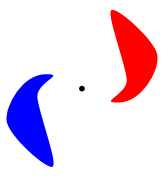
A central inversion, order 2, is operationally differently by dimension. The group [ ]n = [2n−1] represents n orthogonal mirrors in n-dimensional space, or an n-flat subspace of a higher dimensional space. The mirrors of the group [2n−1] are numbered . The order of the mirrors doesn't matter in the case of an inversion. The matrix of a central inversion is , the Identity matrix with negative one on the diagonal.
From that basis, the central inversion has a generator as the product of all the orthogonal mirrors. In Coxeter notation this inversion group is expressed by adding an alternation + to each 2 branch. The alternation symmetry is marked on Coxeter diagram nodes as open nodes.
A Coxeter-Dynkin diagram can be marked up with explicit 2 branches defining a linear sequence of mirrors, open-nodes, and shared double-open nodes to show the chaining of the reflection generators.
For example, [2+,2] and [2,2+] are subgroups index 2 of [2,2], ![]()
![]()
![]()
![]()
![]() , and are represented as
, and are represented as ![]()
![]()
![]()
![]()
![]() (or
(or ![]()
![]()
![]()
![]()
![]()
![]()
![]() ) and
) and ![]()
![]()
![]()
![]()
![]() (or
(or ![]()
![]()
![]()
![]()
![]()
![]()
![]() ) with generators {01,2} and {0,12} respectively. Their common subgroup index 4 is [2+,2+], and is represented by
) with generators {01,2} and {0,12} respectively. Their common subgroup index 4 is [2+,2+], and is represented by ![]()
![]()
![]()
![]()
![]() (or
(or ![]()
![]()
![]()
![]()
![]()
![]()
![]()
![]()
![]() ), with the double-open
), with the double-open ![]() marking a shared node in the two alternations, and a single rotoreflection generator {012}.
marking a shared node in the two alternations, and a single rotoreflection generator {012}.
| Dimension | Coxeter notation | Order | Coxeter diagram | Operation | Generator |
|---|---|---|---|---|---|
| 2 | [2]+ | 2 | 180° rotation, C2 | {01} | |
| 3 | [2+,2+] | 2 | rotoreflection, Ci or S2 | {012} | |
| 4 | [2+,2+,2+] | 2 | double rotation | {0123} | |
| 5 | [2+,2+,2+,2+] | 2 | double rotary reflection | {01234} | |
| 6 | [2+,2+,2+,2+,2+] | 2 | triple rotation | {012345} | |
| 7 | [2+,2+,2+,2+,2+,2+] | 2 | triple rotary reflection | {0123456} |
Rotations and rotary reflections[edit]
Rotations and rotary reflections are constructed by a single single-generator product of all the reflections of a prismatic group, [2p]×[2q]×... where gcd(p,q,...)=1, they are isomorphic to the abstract cyclic group Zn, of order n=2pq.
The 4-dimensional double rotations, [2p+,2+,2q+] (with gcd(p,q)=1), which include a central group, and are expressed by Conway as ±[Cp×Cq],[5] order 2pq. From Coxeter diagram ![]()
![]()
![]()
![]()
![]()
![]()
![]()
![]()
![]() , generators {0,1,2,3}, requires two generator for [2p+,2+,2q+],
, generators {0,1,2,3}, requires two generator for [2p+,2+,2q+], ![]()
![]()
![]()
![]()
![]()
![]()
![]()
![]()
![]() as {0123,0132}. Half groups, [2p+,2+,2q+]+, or cyclic graph, [(2p+,2+,2q+,2+)],
as {0123,0132}. Half groups, [2p+,2+,2q+]+, or cyclic graph, [(2p+,2+,2q+,2+)], ![]()
![]()
![]()
![]()
![]()
![]()
![]()
![]()
![]()
![]()
![]() expressed by Conway is [Cp×Cq], order pq, with one generator, like {0123}.
expressed by Conway is [Cp×Cq], order pq, with one generator, like {0123}.
If there is a common factor f, the double rotation can be written as 1⁄f[2pf+,2+,2qf+] (with gcd(p,q)=1), generators {0123,0132}, order 2pqf. For example, p=q=1, f=2, 1⁄2[4+,2+,4+] is order 4. And 1⁄f[2pf+,2+,2qf+]+, generator {0123}, is order pqf. For example, 1⁄2[4+,2+,4+]+ is order 2, a central inversion.
In general a n-rotation group, [2p1+,2,2p2+,2,...,pn+] may require up to n generators if gcd(p1,..,pn)>1, as a product of all mirrors, and then swapping sequential pairs. The half group, [2p1+,2,2p2+,2,...,pn+]+ has generators squared. n-rotary reflections are similar.
| Dimension | Coxeter notation | Order | Coxeter diagram | Operation | Generators | Direct subgroup | |
|---|---|---|---|---|---|---|---|
| 2 | [2p]+ | 2p | Rotation | {01} | [2p]+2 = [p]+ | Simple rotation: [2p]+2 = [p]+ order p | |
| 3 | [2p+,2+] | rotary reflection | {012} | [2p+,2+]+ = [p]+ | |||
| 4 | [2p+,2+,2+] | double rotation | {0123} | [2p+,2+,2+]+ = [p]+ | |||
| 5 | [2p+,2+,2+,2+] | double rotary reflection | {01234} | [2p+,2+,2+,2+]+ = [p]+ | |||
| 6 | [2p+,2+,2+,2+,2+] | triple rotation | {012345} | [2p+,2+,2+,2+,2+]+ = [p]+ | |||
| 7 | [2p+,2+,2+,2+,2+,2+] | triple rotary reflection | {0123456} | [2p+,2+,2+,2+,2+,2+]+ = [p]+ | |||
| 4 | [2p+,2+,2q+] | 2pq | double rotation | {0123, 0132} | [2p+,2+,2q+]+ | Double rotation: [2p+,2+,2q+]+ order pq | |
| 5 | [2p+,2+,2q+,2+] | double rotary reflection | {01234, 01243} | [2p+,2+,2q+,2+]+ | |||
| 6 | [2p+,2+,2q+,2+,2+] | triple rotation | {012345, 012354, 013245} | [2p+,2+,2q+,2+,2+]+ | |||
| 7 | [2p+,2+,2q+,2+,2+,2+] | triple rotary reflection | {0123456, 0123465, 0124356, 0124356} | [2p+,2+,2q+,2+,2+,2+]+ | |||
| 6 | [2p+,2+,2q+,2+,2r+] | 2pqr | triple rotation | {012345, 012354, 013245} | [2p+,2+,2q+,2+,2r+]+ | Triple rotation: [2p+,2+,2q+,2+,2r+]+ order pqr | |
| 7 | [2p+,2+,2q+,2+,2r+,2+] | triple rotary reflection | {0123456, 0123465, 0124356, 0213456} | [2p+,2+,2q+,2+,2r+,2+]+ | |||
Commutator subgroups[edit]

Simple groups with only odd-order branch elements have only a single rotational/translational subgroup of order 2, which is also the commutator subgroup, examples [3,3]+, [3,5]+, [3,3,3]+, [3,3,5]+. For other Coxeter groups with even-order branches, the commutator subgroup has index 2c, where c is the number of disconnected subgraphs when all the even-order branches are removed.[6]
For example, [4,4] has three independent nodes in the Coxeter diagram when the 4s are removed, so its commutator subgroup is index 23, and can have different representations, all with three + operators: [4+,4+]+, [1+,4,1+,4,1+], [1+,4,4,1+]+, or [(4+,4+,2+)]. A general notation can be used with +c as a group exponent, like [4,4]+3.
Example subgroups[edit]
Rank 2 example subgroups[edit]
Dihedral symmetry groups with even-orders have a number of subgroups. This example shows two generator mirrors of [4] in red and green, and looks at all subgroups by halfing, rank-reduction, and their direct subgroups. The group [4], ![]()
![]()
![]() has two mirror generators 0, and 1. Each generate two virtual mirrors 101 and 010 by reflection across the other.
has two mirror generators 0, and 1. Each generate two virtual mirrors 101 and 010 by reflection across the other.
| Subgroups of [4] | |||||||||||
|---|---|---|---|---|---|---|---|---|---|---|---|
| Index | 1 | 2 (half) | 4 (Rank-reduction) | ||||||||
| Diagram |  |  |  |  |  | ||||||
| Coxeter | [1,4,1] = [4] | [1+,4,1] = [1+,4] = [2] | [1,4,1+] = [4,1+] = [2] | [2,1+] = [1] = [ ] | [1+,2] = [1] = [ ] | ||||||
| Generators | {0,1} | {101,1} | {0,010} | {0} | {1} | ||||||
| Direct subgroups | |||||||||||
| Index | 2 | 4 | 8 | ||||||||
| Diagram | 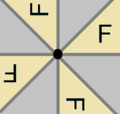 |  |  | ||||||||
| Coxeter | [4]+ | [4]+2 = [1+,4,1+] = [2]+ | [ ]+ | ||||||||
| Generators | {01} | {(01)2} | {02} = {12} = {(01)4} = { } | ||||||||
Rank 3 Euclidean example subgroups[edit]
The [4,4] group has 15 small index subgroups. This table shows them all, with a yellow fundamental domain for pure reflective groups, and alternating white and blue domains which are paired up to make rotational domains. Cyan, red, and green mirror lines correspond to the same colored nodes in the Coxeter diagram. Subgroup generators can be expressed as products of the original 3 mirrors of the fundamental domain, {0,1,2}, corresponding to the 3 nodes of the Coxeter diagram, ![]()
![]()
![]()
![]()
![]() . A product of two intersecting reflection lines makes a rotation, like {012}, {12}, or {02}. Removing a mirror causes two copies of neighboring mirrors, across the removed mirror, like {010}, and {212}. Two rotations in series cut the rotation order in half, like {0101} or {(01)2}, {1212} or {(02)2}. A product of all three mirrors creates a transreflection, like {012} or {120}.
. A product of two intersecting reflection lines makes a rotation, like {012}, {12}, or {02}. Removing a mirror causes two copies of neighboring mirrors, across the removed mirror, like {010}, and {212}. Two rotations in series cut the rotation order in half, like {0101} or {(01)2}, {1212} or {(02)2}. A product of all three mirrors creates a transreflection, like {012} or {120}.
| Small index subgroups of [4,4] | |||||||||||
|---|---|---|---|---|---|---|---|---|---|---|---|
| Index | 1 | 2 | 4 | ||||||||
| Diagram |  |  |  |  |  |  | |||||
| Coxeter | [1,4,1,4,1] = [4,4] | [1+,4,4] | [4,4,1+] | [4,1+,4] | [1+,4,4,1+] | [4+,4+] | |||||
| Generators | {0,1,2} | {010,1,2} | {0,1,212} | {0,101,121,2} | {010,1,212,20102} | {(01)2,(12)2,012,120} | |||||
| Orbifold | *442 | *2222 | 22× | ||||||||
| Semidirect subgroups | |||||||||||
| Index | 2 | 4 | |||||||||
| Diagram |  |  | 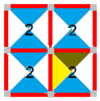 |  |  | ||||||
| Coxeter | [4,4+] | [4+,4] | [(4,4,2+)] | [4,1+,4,1+] | [1+,4,1+,4] | ||||||
| Generators | {0,12} | {01,2} | {02,1,212} | {0,101,(12)2} | {(01)2,121,2} | ||||||
| Orbifold | 4*2 | 2*22 | |||||||||
| Direct subgroups | |||||||||||
| Index | 2 | 4 | 8 | ||||||||
| Diagram | 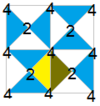 |  |  |  | 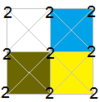 | ||||||
| Coxeter | [4,4]+ | [4,4+]+ | [4+,4]+ | [(4,4,2+)]+ | [4,4]+3 = [(4+,4+,2+)] = [1+,4,1+,4,1+] = [4+,4+]+ | ||||||
| Generators | {01,12} | {(01)2,12} | {01,(12)2} | {02,(01)2,(12)2} | {(01)2,(12)2,2(01)22} | ||||||
| Orbifold | 442 | 2222 | |||||||||
| Radical subgroups | |||||||||||
| Index | 8 | 16 | |||||||||
| Diagram | 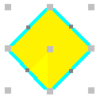 |  |  |  | |||||||
| Coxeter | [4,4*] | [4*,4] | [4,4*]+ | [4*,4]+ | |||||||
| Orbifold | *2222 | 2222 | |||||||||
Hyperbolic example subgroups[edit]
The same set of 15 small subgroups exists on all triangle groups with even order elements, like [6,4] in the hyperbolic plane:
| Small index subgroups of [6,4] | |||||||||||
|---|---|---|---|---|---|---|---|---|---|---|---|
| Index | 1 | 2 | 4 | ||||||||
| Diagram | 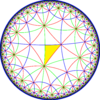 | 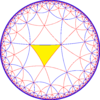 | 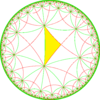 |  | 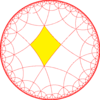 | 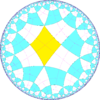 | |||||
| Coxeter | [1,6,1,4,1] = [6,4] | [1+,6,4] | [6,4,1+] | [6,1+,4] | [1+,6,4,1+] | [6+,4+] | |||||
| Generators | {0,1,2} | {010,1,2} | {0,1,212} | {0,101,121,2} | {010,1,212,20102} | {(01)2,(12)2,012} | |||||
| Orbifold | *642 | *443 | *662 | *3222 | *3232 | 32× | |||||
| Semidirect subgroups | |||||||||||
| Diagram | 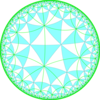 | 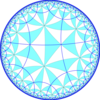 | 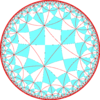 | 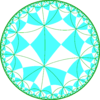 | 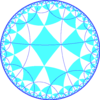 | ||||||
| Coxeter | [6,4+] | [6+,4] | [(6,4,2+)] | [6,1+,4,1+] = | [1+,6,1+,4] = | ||||||
| Generators | {0,12} | {01,2} | {02,1,212} | {0,101,(12)2} | {(01)2,121,2} | ||||||
| Orbifold | 4*3 | 6*2 | 2*32 | 2*33 | 3*22 | ||||||
| Direct subgroups | |||||||||||
| Index | 2 | 4 | 8 | ||||||||
| Diagram | 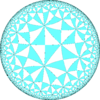 | 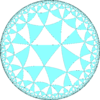 | 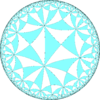 | 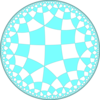 | 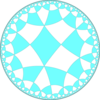 | ||||||
| Coxeter | [6,4]+ | [6,4+]+ | [6+,4]+ | [(6,4,2+)]+ | [6+,4+]+ = [1+,6,1+,4,1+] = | ||||||
| Generators | {01,12} | {(01)2,12} | {01,(12)2} | {02,(01)2,(12)2} | {(01)2,(12)2,201012} | ||||||
| Orbifold | 642 | 443 | 662 | 3222 | 3232 | ||||||
| Radical subgroups | |||||||||||
| Index | 8 | 12 | 16 | 24 | |||||||
| Diagram | 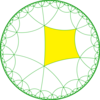 | 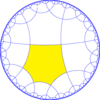 | |||||||||


 French
French Deutsch
Deutsch


































